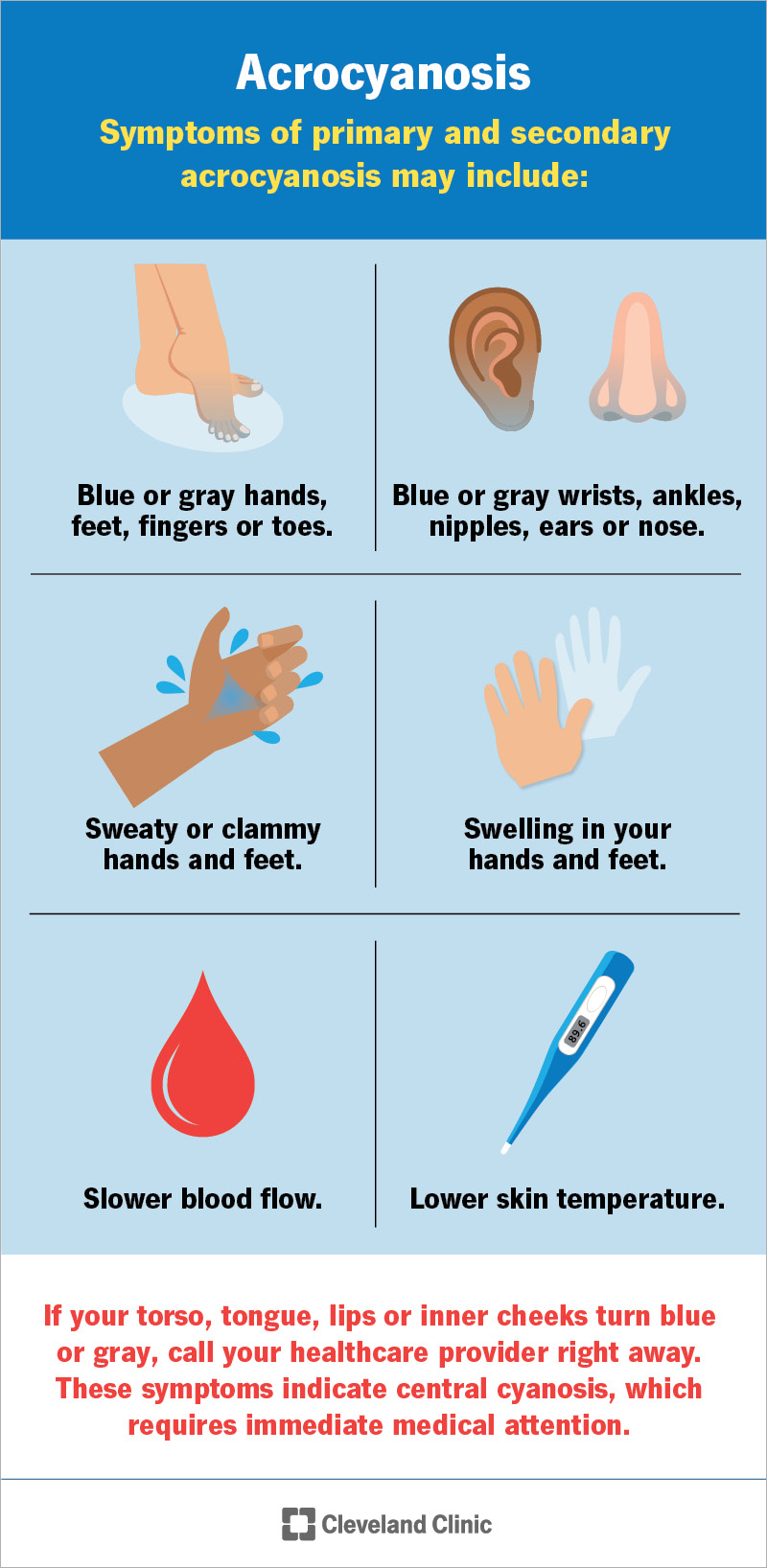Acrocyanosis causes your fingers, toes, hands and feet to become bluish, white or gray in color. It happens when your arteries tighten for longer than they should. Acrocyanosis common in newborns, but it can happen to anyone. In many cases, it’s harmless. But it could point to an underlying health condition.
Advertisement
Cleveland Clinic is a non-profit academic medical center. Advertising on our site helps support our mission. We do not endorse non-Cleveland Clinic products or services. Policy
Acrocyanosis is a condition that causes your hands or feet (and sometimes other areas of your body) to turn a bluish, white or gray color. It occurs when an artery tightens for longer than it should (vasospasm), causing your blood vessels to narrow. As a result, your surrounding tissues receive less blood and oxygen and become discolored. Another name for acrocyanosis is peripheral cyanosis.
Advertisement
Cleveland Clinic is a non-profit academic medical center. Advertising on our site helps support our mission. We do not endorse non-Cleveland Clinic products or services. Policy
Anyone can experience episodes of acrocyanosis. If you’ve ever noticed a blue or gray hue around your nailbeds after getting out of a cold shower or being out in the snow without gloves, that’s acrocyanosis. In many cases, it’s harmless and it goes away once you warm up. But in other instances, it’s a sign of an underlying health condition.
Whether acrocyanosis is a cause of concern depends on the type you have. There are two types — primary and secondary.
Primary acrocyanosis is a type of functional peripheral arterial disease. The term “functional” means there’s no damage to your blood vessels. Rather, your blood vessels narrow and widen in response to things like temperature changes or even emotional stress. “Peripheral” refers to areas “away from the center” of your body, like your hands and feet.
Anyone can get primary acrocyanosis, but it’s most common in newborns, adolescents and people in their 20s. This type of acrocyanosis usually affects both sides of your body (for example, both hands or both feet). Primary acrocyanosis isn’t painful.
Secondary acrocyanosis typically occurs alongside other health conditions. The way it appears can vary depending on the underlying cause. Unlike primary acrocyanosis, secondary acrocyanosis usually occurs on one side of your body. It often causes pain and tissue damage — and it usually requires treatment.
Advertisement

Symptoms of primary and secondary acrocyanosis may include:
If your torso, tongue, lips or inner cheeks turn blue or gray, call your healthcare provider right away. These symptoms indicate central cyanosis, which requires immediate medical attention.
Causes depend on what type of acrocyanosis you have:
Experts are still researching primary acrocyanosis and exactly why it happens. It occurs when your blood vessels narrow (constrict). Possible causes of this constriction vary and include:
Many newborns have acrocyanosis in their first few hours of life. This is normal and nothing to worry about. It occurs because your baby’s blood carries oxygen to their vital organs first, like their lungs, kidneys and brain. As your baby’s body adjusts to new circulation patterns, acrocyanosis will go away. The bluish or white hue might come back later if your baby gets cold. This is also normal and should go away on its own.
Experts know more about secondary acrocyanosis because they’ve studied the underlying diseases that commonly occur with it. Sometimes secondary acrocyanosis is the first sign of disease. In other cases, it may develop slowly over time.
Causes of secondary acrocyanosis include:
If you have any of the health conditions listed above, you have an increased risk for secondary acrocyanosis.
You’re more likely to develop primary acrocyanosis if you:
A healthcare provider can usually tell if you have acrocyanosis by looking at your skin during a physical examination. They’ll check your hands and feet to see if discoloration affects one or both sides of your body.
Depending on your situation, your provider may recommend tests to determine if you have an underlying condition. These tests may include:
Advertisement
Primary acrocyanosis isn’t harmful and there’s usually no need to treat it. Symptoms should go away once your body warms up.
Treatment for secondary acrocyanosis depends on the underlying health condition. Treating the root cause can improve acrocyanosis symptoms.
Primary acrocyanosis is a harmless condition that goes away on its own. Many people outgrow it altogether.
The outlook for secondary acrocyanosis depends more on the underlying health condition. It can be serious for some people. If you develop symptoms of acrocyanosis, tell your healthcare provider. They can determine whether you have another condition that’s causing it.
You can’t always prevent this condition, especially secondary acrocyanosis. It occurs alongside other health conditions that are beyond your control. But you can reduce your risk for primary acrocyanosis by wearing warm clothing (like gloves and thermal socks) in colder weather. You can also buy hand warmers at your local pharmacy to keep in your coat pockets.
To reduce the risk of acrocyanosis in your newborn, swaddle them in warm blankets. Be sure to wrap them in a towel as soon as you finish bathing them. This will help keep them warm. Remember, acrocyanosis in newborns is normal and should go away once your baby warms up again.
Advertisement
You should schedule an appointment with your healthcare provider if you:
Noticing that your skin has a blue or gray hue can feel scary. It can be especially concerning for parents who notice acrocyanosis in their newborn baby. This condition can occur for many reasons. Figuring out the root cause is key. In many cases, it’s harmless. But if you have pain or other symptoms alongside acrocyanosis, it’s time to call your healthcare provider. They can determine whether you have an underlying health condition and recommend appropriate treatment.
Advertisement
Cleveland Clinic’s primary care providers offer lifelong medical care. From sinus infections and high blood pressure to preventive screening, we’re here for you.

Last reviewed on 09/25/2023.
Learn more about the Health Library and our editorial process.